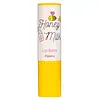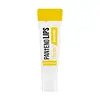What's inside
What's inside
 Key Ingredients
Key Ingredients

 Benefits
Benefits

 Concerns
Concerns

 Ingredients Side-by-side
Ingredients Side-by-side

Petrolatum
EmollientDiisostearyl Malate
EmollientMethyl Hydrogenated Rosinate
PerfumingCaprylic/Capric Triglyceride
MaskingRicinus Communis Seed Oil
MaskingMicrocrystalline Wax
Emulsion StabilisingOctyldodecanol
EmollientCetyl Ricinoleate
EmollientOzokerite
Emulsion StabilisingPolyethylene
AbrasivePhytosteryl/Isostearyl/Cetyl/Stearyl/Behenyl Dimer Dilinoleate
Skin ConditioningHydrogenated Vegetable Oil
EmollientDicalcium Phosphate
AbrasiveHoney Extract
HumectantMilk Protein Extract
Glycerin
HumectantPolyglyceryl-2 Triisostearate
EmulsifyingTocopheryl Acetate
AntioxidantWater
Skin ConditioningPropylene Glycol
HumectantPhenoxyethanol
PreservativeParfum
MaskingCI 19140
Cosmetic ColorantPetrolatum, Diisostearyl Malate, Methyl Hydrogenated Rosinate, Caprylic/Capric Triglyceride, Ricinus Communis Seed Oil, Microcrystalline Wax, Octyldodecanol, Cetyl Ricinoleate, Ozokerite, Polyethylene, Phytosteryl/Isostearyl/Cetyl/Stearyl/Behenyl Dimer Dilinoleate, Hydrogenated Vegetable Oil, Dicalcium Phosphate, Honey Extract, Milk Protein Extract, Glycerin, Polyglyceryl-2 Triisostearate, Tocopheryl Acetate, Water, Propylene Glycol, Phenoxyethanol, Parfum, CI 19140
Paraffinum Liquidum
EmollientPolyisobutene
Ethylene/Propylene/Styrene Copolymer
Helianthus Annuus Seed Oil
EmollientParfum
MaskingGlycerin
HumectantButylene/Ethylene/Styrene Copolymer
Cetearyl Olivate
Macadamia Ternifolia Seed Oil
EmollientOlea Europaea Fruit Oil
MaskingPersea Gratissima Oil
Skin ConditioningEclipta Prostrata Extract
Skin ConditioningSorbitan Olivate
EmulsifyingWater
Skin ConditioningGlycine Soja Oil
EmollientTocopherol
AntioxidantTocopheryl Acetate
AntioxidantMelia Azadirachta Leaf Extract
Skin ConditioningPropolis Extract
Skin ConditioningPanthenol
Skin ConditioningBenzyl Salicylate
PerfumingLinalool
PerfumingBHT
AntioxidantHexyl Cinnamal
PerfumingHydroxycitronellal
PerfumingCitronellol
PerfumingCinnamyl Alcohol
PerfumingMoringa Oleifera Seed Oil
EmollientBixa Orellana Seed Oil
EmollientRoyal Jelly Extract
Skin ConditioningHoney Extract
HumectantCollagen
Moisturising1,2-Hexanediol
Skin ConditioningLeuconostoc/Radish Root Ferment Filtrate
AntimicrobialParaffinum Liquidum, Polyisobutene, Ethylene/Propylene/Styrene Copolymer, Helianthus Annuus Seed Oil, Parfum, Glycerin, Butylene/Ethylene/Styrene Copolymer, Cetearyl Olivate, Macadamia Ternifolia Seed Oil, Olea Europaea Fruit Oil, Persea Gratissima Oil, Eclipta Prostrata Extract, Sorbitan Olivate, Water, Glycine Soja Oil, Tocopherol, Tocopheryl Acetate, Melia Azadirachta Leaf Extract, Propolis Extract, Panthenol, Benzyl Salicylate, Linalool, BHT, Hexyl Cinnamal, Hydroxycitronellal, Citronellol, Cinnamyl Alcohol, Moringa Oleifera Seed Oil, Bixa Orellana Seed Oil, Royal Jelly Extract, Honey Extract, Collagen, 1,2-Hexanediol, Leuconostoc/Radish Root Ferment Filtrate
Ingredients Explained
These ingredients are found in both products.
Ingredients higher up in an ingredient list are typically present in a larger amount.
Glycerin is already naturally found in your skin. It helps moisturize and protect your skin.
A study from 2016 found glycerin to be more effective as a humectant than AHAs and hyaluronic acid.
As a humectant, it helps the skin stay hydrated by pulling moisture to your skin. The low molecular weight of glycerin allows it to pull moisture into the deeper layers of your skin.
Hydrated skin improves your skin barrier; Your skin barrier helps protect against irritants and bacteria.
Glycerin has also been found to have antimicrobial and antiviral properties. Due to these properties, glycerin is often used in wound and burn treatments.
In cosmetics, glycerin is usually derived from plants such as soybean or palm. However, it can also be sourced from animals, such as tallow or animal fat.
This ingredient is organic, colorless, odorless, and non-toxic.
Glycerin is the name for this ingredient in American English. British English uses Glycerol/Glycerine.
Learn more about GlycerinThis ingredient comes from honey made by bees. It is hydrating, antibacterial, anti-aging, and skin soothing.
Honey also contains amino acids, peptides, Vitamins A, C, and E.
The humectant property of honey draws moisture from the air to your skin. This makes it great at helping to hydrate the skin.
Honey may help reduce the signs of aging due to its antioxidant properties. Fun fact: darker honey has more antioxidants than light honey. The antibacterial property of honey may make it effective at helping to treat acne by killing acne-causing bacteria.
Many people wonder if honey extract is vegan. It is technically a byproduct from bees. This is because honey is created from the digestive enzymes in a bee's stomach.
Remember to be kind to bees :) They are important for many ecosystems and are endangered.
Learn more about Honey ExtractParfum is a catch-all term for an ingredient or more that is used to give a scent to products.
Also called "fragrance", this ingredient can be a blend of hundreds of chemicals or plant oils. This means every product with "fragrance" or "parfum" in the ingredients list is a different mixture.
For instance, Habanolide is a proprietary trade name for a specific aroma chemical. When used as a fragrance ingredient in cosmetics, most aroma chemicals fall under the broad labeling category of “FRAGRANCE” or “PARFUM” according to EU and US regulations.
The term 'parfum' or 'fragrance' is not regulated in many countries. In many cases, it is up to the brand to define this term.
For instance, many brands choose to label themselves as "fragrance-free" because they are not using synthetic fragrances. However, their products may still contain ingredients such as essential oils that are considered a fragrance by INCI standards.
One example is Calendula flower extract. Calendula is an essential oil that still imparts a scent or 'fragrance'.
Depending on the blend, the ingredients in the mixture can cause allergies and sensitivities on the skin. Some ingredients that are known EU allergens include linalool and citronellol.
Parfum can also be used to mask or cover an unpleasant scent.
The bottom line is: not all fragrances/parfum/ingredients are created equally. If you are worried about fragrances, we recommend taking a closer look at an ingredient. And of course, we always recommend speaking with a professional.
Learn more about ParfumTocopheryl Acetate is AKA Vitamin E. It is an antioxidant and protects your skin from free radicals. Free radicals damage the skin by breaking down collagen.
One study found using Tocopheryl Acetate with Vitamin C decreased the number of sunburned cells.
Tocopheryl Acetate is commonly found in both skincare and dietary supplements.
Learn more about Tocopheryl AcetateWater. It's the most common cosmetic ingredient of all. You'll usually see it at the top of ingredient lists, meaning that it makes up the largest part of the product.
So why is it so popular? Water most often acts as a solvent - this means that it helps dissolve other ingredients into the formulation.
You'll also recognize water as that liquid we all need to stay alive. If you see this, drink a glass of water. Stay hydrated!
Learn more about Water